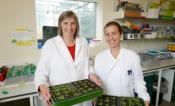RUBP Regeneration refers to the cyclical process where the photosynthetic enzyme Rubisco fixes carbon dioxide into the sugars that fuel plant growth and productivity. Carbon dioxide enters the cycle and is fixed by Rubisco to a 5-carbon sugar called ribulose biphosphate (RuBP), which is immediately broken down to form two 3-carbon molecules of phosphoglycerate (PGA). Only one-sixth of the PGA carbon is converted to sugar—the rest of the carbon is used to recycle RuBP as the cycle continues. There are 11 reactions involved in this cycle, several of which models have identified as limiting steps that are negatively impacted by the changing climate. Our team is resolving these bottlenecks in RuBP regeneration to increase the efficiency that plants generate the sugars needed to increase crop productivity.

Third breakthrough demonstrates photosynthetic hacks can boost yield, conserve water
RIPE has resolved two major photosynthetic bottlenecks to boost plant productivity by 27 percent in real-world field conditions.

Scientists boost crop production by 47 percent by speeding up photorespiration
RIPE has increased crop production 27 to 47 percent by speeding up a process called photorespiration.

Incremental discovery may one day lead to photosynthetic breakthrough
While we have modeled the more-than-100 major steps of photosynthesis, scientists are still discovering the purpose of proteins that can be engineered to increase yield. RIPE has uncovered secrets about another protein, CP12—the full understanding of which may provide an additional route to boost yields in the future.











